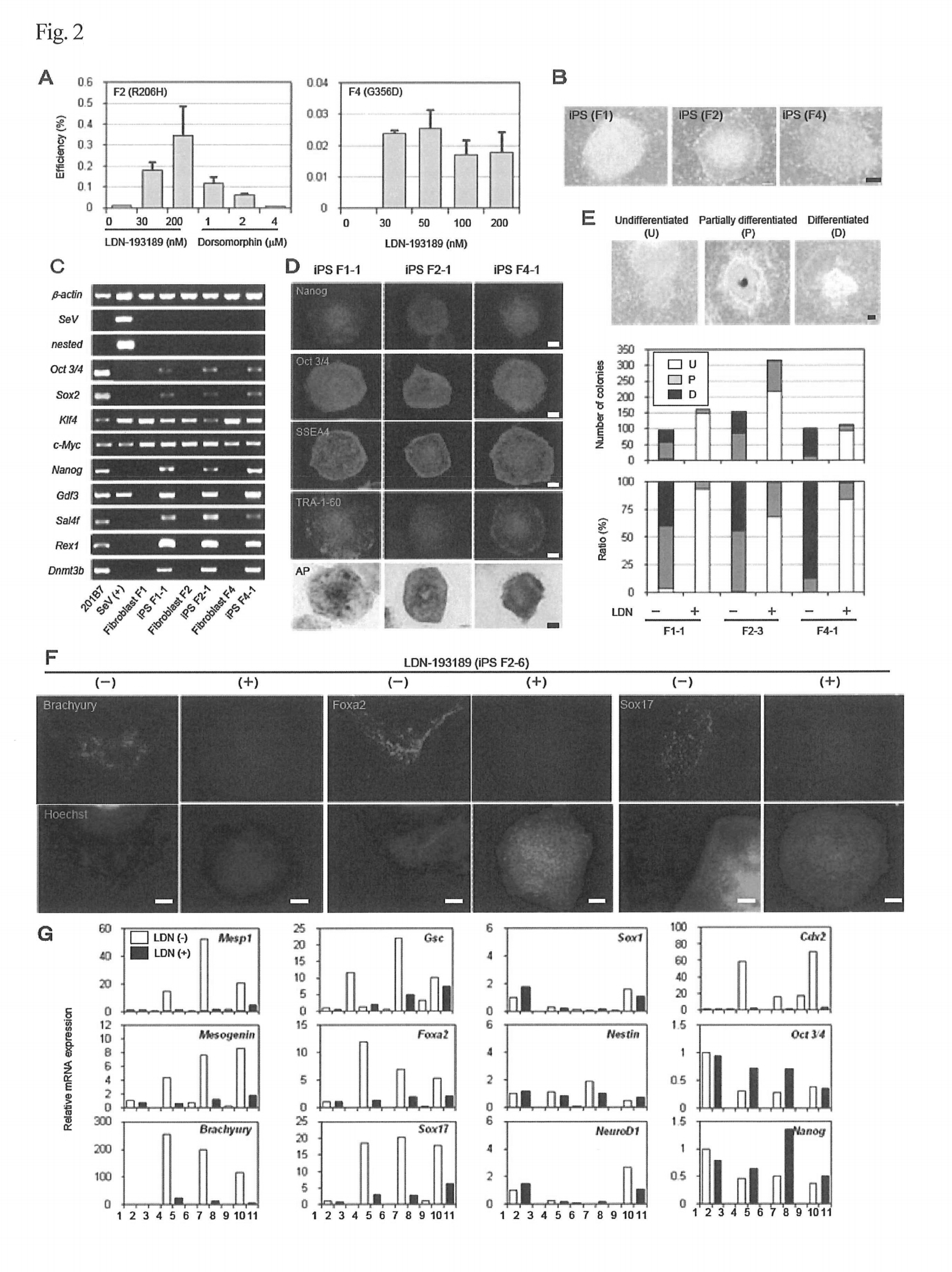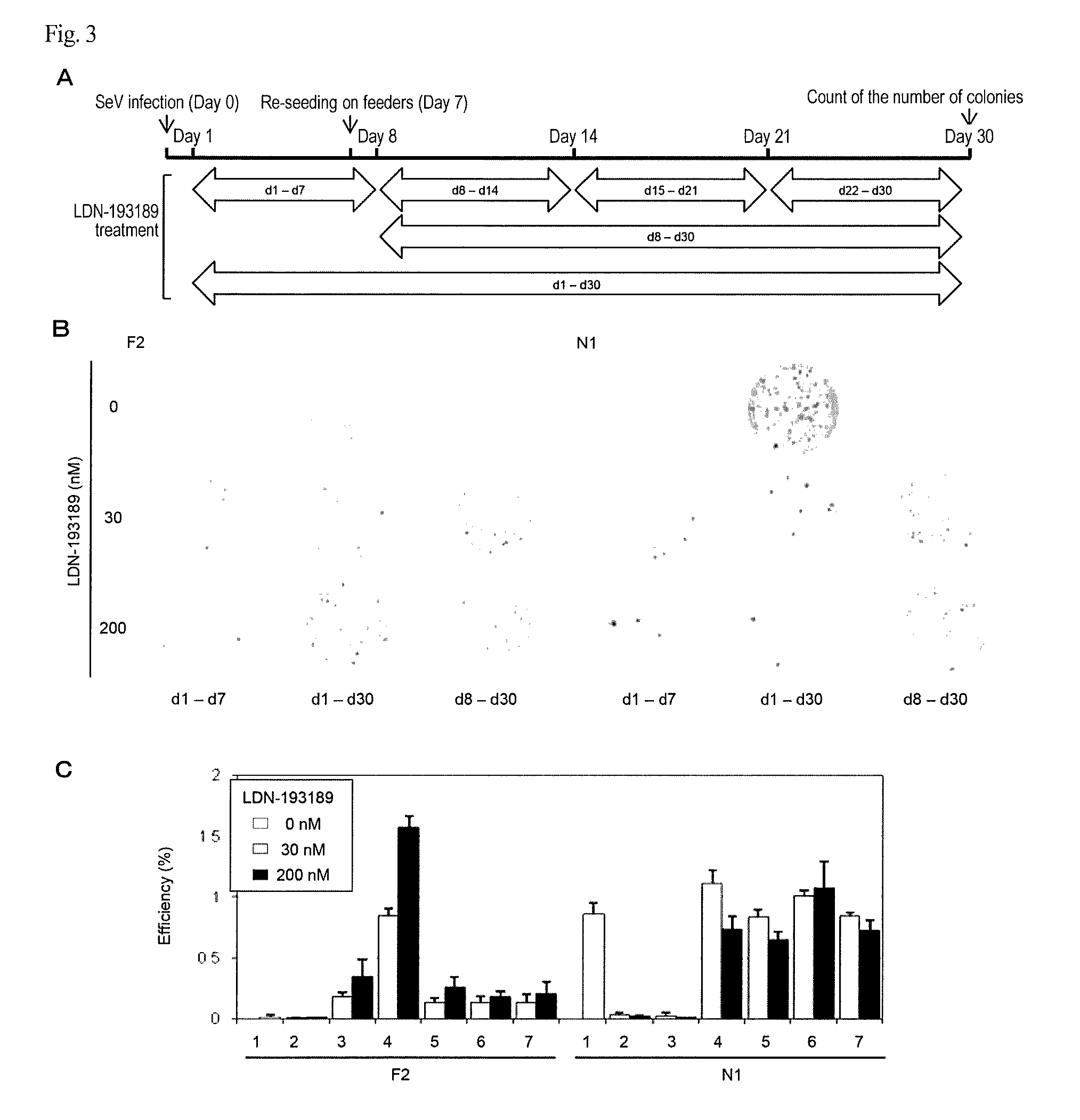Method of screening for substances capable of promoting induction of induced pluripotent stem cells
a technology screening methods, which is applied in the field of screening substances capable of promoting can solve the problems of evaluating whether or not selected drugs can actually function as effective drugs, time-consuming drug efficacy evaluation, and unable to evaluate medicinal effects, etc., to achieve efficient screening, high-reliability drug candidates, and promote the induction of induced pluripotent stem cells
- Summary
- Abstract
- Description
- Claims
- Application Information
AI Technical Summary
Benefits of technology
Problems solved by technology
Method used
Image
Examples
example 1
(A) Materials and Method
(1) Production of Skin-Derived Fibroblasts
[0069]Fibroblasts were produced from skin biopsy explants of FOP patients and healthy volunteers with informed consent from them in accordance with the protocol approved by the ethical committee. Skin samples obtained from the patients and healthy volunteers were finely minced and cultured in D-MEM medium supplemented with 10% fetal bovine serum (FBS). After fibroblasts were observed to have grown, the fibroblasts were allowed to proliferate for induction into iPS cells.
(2) Maintenance and Generation of iPS Cells
[0070]Human iPS cells were maintained on MEF feeder cells treated with mitomycin C (MMC) in human iPS medium containing DMEM / F12 (Sigma) supplemented with 20% KNOCKOUT (trademark) serum replacement (KSR, Invitrogen), 2 mM L-glutamine, 1×10−4 M non-essential amino acid (NEAA, Sigma), 1×10−4 M 2-mercaptoethanol (Sigma), 0.5% penicillin and streptomycin (Nacalai Tesque, Japan), and a 5 ng / mL basic fibroblast grow...
example 2
[0095]In this Example, sodium butyrate (NaB) was used to induce iPS cells from fibroblasts of infantile Krabbe disease patients.
[0096]As in the case of Example 1, fibroblasts were prepared from skin samples of infantile Krabbe disease patients and were seeded on a 6-well plate (5×105 cells / well) on the day before Sendai virus (SeV) infection. The fibroblasts were infected with SeV capable of expressing Oct-3 / 4, Sox2, Klf4, and cMyc. On the next day of infection, medium (DMEM+10% FBS+500 uM sodium butyrate) was renewed, and the medium was renewed on each of the following days. The fibroblasts were recovered on day 7 after viral infection and 3.5×105 cells were seeded on mitomycin-treated mouse embryonic fibroblasts (MMC-MEF). On the next day of seeding, the cells were divided into the following groups: a test group of human embryonic stem cell (hES cell) culture medium [DMEM / F12+20% Knockout serum replacement (KSR)+2 mM L-glutamate+100 mM non-essential amino acid+100 mM 2-mercaptoeth...
PUM
| Property | Measurement | Unit |
|---|---|---|
| pH | aaaaa | aaaaa |
| pH | aaaaa | aaaaa |
| size | aaaaa | aaaaa |
Abstract
Description
Claims
Application Information
 Login to View More
Login to View More - R&D
- Intellectual Property
- Life Sciences
- Materials
- Tech Scout
- Unparalleled Data Quality
- Higher Quality Content
- 60% Fewer Hallucinations
Browse by: Latest US Patents, China's latest patents, Technical Efficacy Thesaurus, Application Domain, Technology Topic, Popular Technical Reports.
© 2025 PatSnap. All rights reserved.Legal|Privacy policy|Modern Slavery Act Transparency Statement|Sitemap|About US| Contact US: help@patsnap.com



